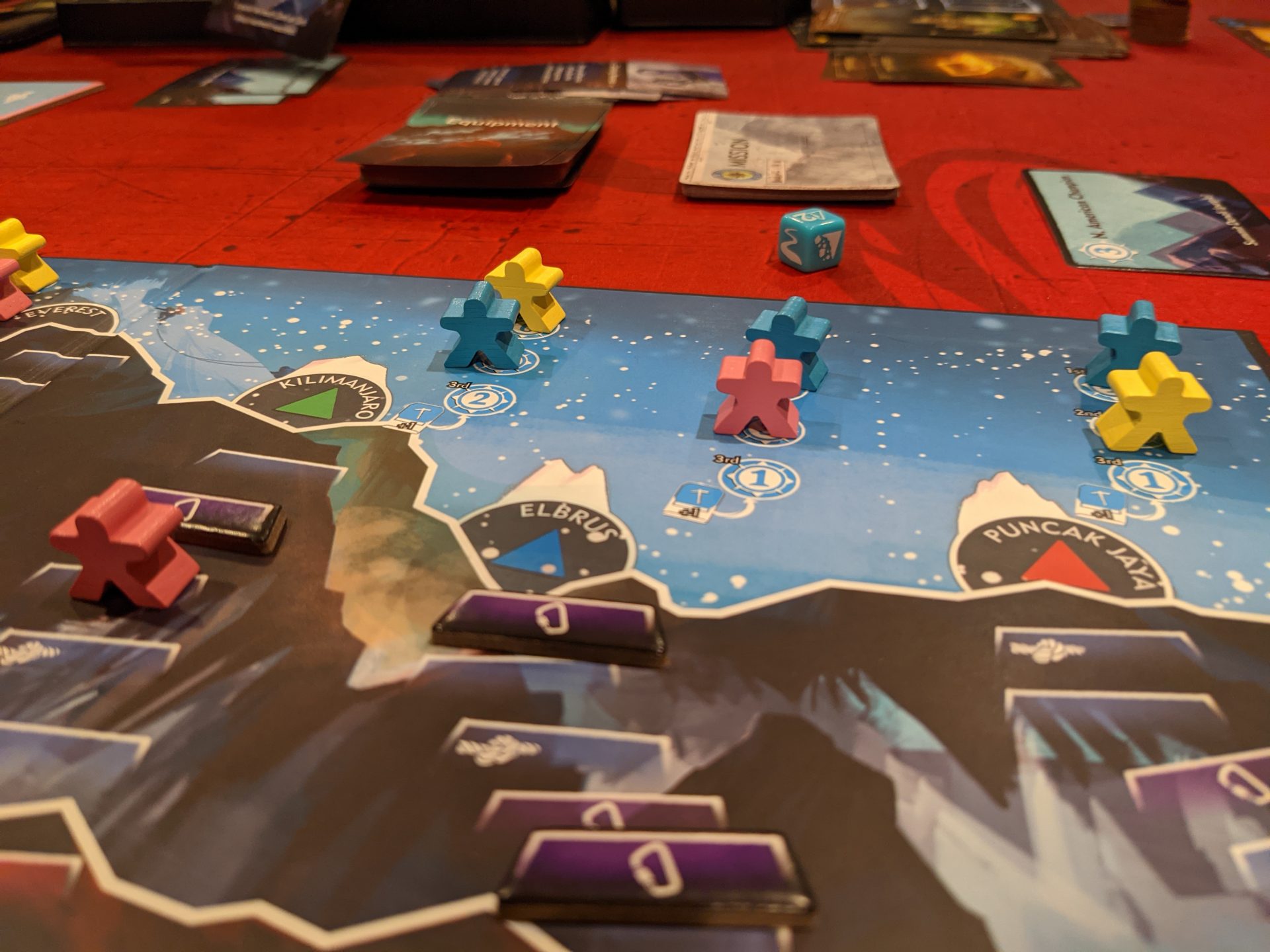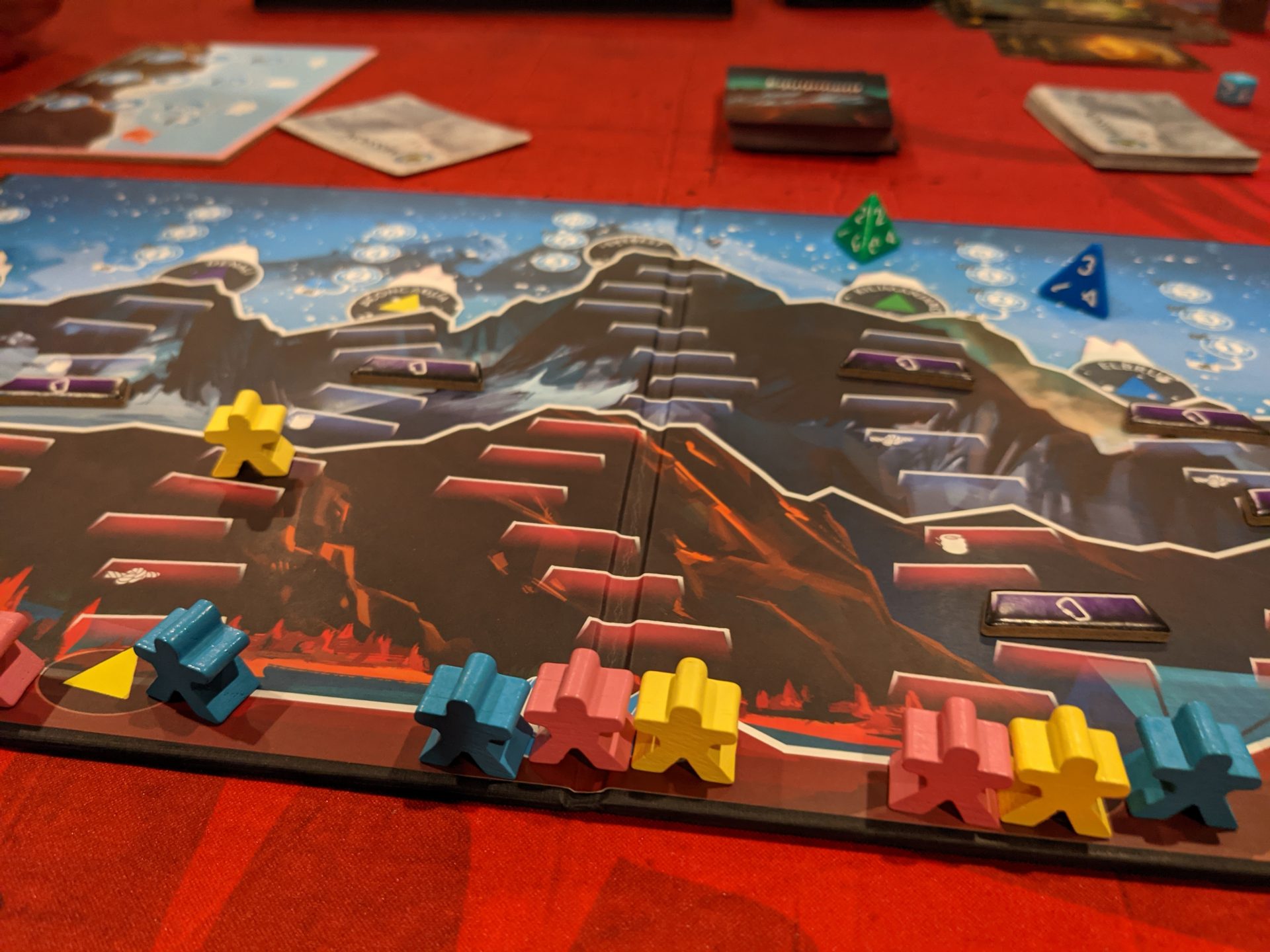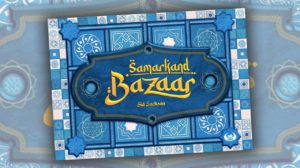Disclosure: Meeple Mountain received a free copy of this product in exchange for an honest, unbiased review. This review is not intended to be an endorsement.
I love dice. I really do. But there’s one die that has always been an enigma to me: the 4-sided die. The D4—shorthand for “four-sided die”—is a small triangle that doesn’t really roll in the same, satisfying way that a D6, D10 or D20 rolls. And you almost never see a custom D4, right? (I have some issues with a D8 as well, since a D8 tumbles more than it rolls.)
7 Summits, by Deep Water Games, takes the D4 to new heights by making it a “Mountain Die”, a cute spin on the black sheep of the dice family. Does making the D4 a Mountain Die make 7 Summits interesting?

Meeple(s) Mountain
The gameplay of 7 Summits is a cinch: once at least one player has reached the summit space of each of the 7 mountains on the board, whoever has the most points is the winner.
The start player in a round rolls 6 D4s, color-coded with 6 of the 7 mountains on the board. (Mount Everest is the 7th mountain but is not assigned a specific die.) After placing each die at the base of its respective summit, players go in clockwise order choosing one die and moving their respective meeple on that mountain up that number of spaces OR on Everest. Along the way, each mountain has spaces which grant one-time bonuses or a one-step boost on one of 3 Skill tracks, which grant you one-time or ongoing bonuses on your player board during the game.
After finishing the initial movement granted by the die roll, players can choose to stay put or “Press On.” This press-your-luck mechanic, where you roll 1 or 2 “Risk” dice, allows a lucky player to move up on one mountain more than once in a single turn; it also means that an unlucky player will fall to the base of that mountain track, losing all progress made on that and previous turns.
Players must land exactly in the final space of the tracks up a mountain to summit/score them. Points range from 4-10 points for reaching the first space, and that makes up the majority of a player’s score in 7 Summits. In addition, players are dealt one secret mission card at the start of the game, so you have something to aim for that might get you an additional 2-3 points if you meet its conditions, with additional missions available during gameplay. Equipment cards also can be used to break the rules of 7 Summits as one-time actions before or after moving one of your meeples, expanding your options for each turn.

Cliffhanger: Does It Work?
Depends.
7 Summits—when played by adults—is a very average experience. Start the round, roll the 6 Mountain Dice, and pick the die that moves your meeple up a mountain the farthest, unless a roll would get one of your meeples directly onto the summit space. You almost HAVE to utilize the “Press On” ability to press your luck, because otherwise it just isn’t that interesting to move up 2 spaces then pass unless that move gets you a boost on one of your Skill tracks.
Everest will always be a race because it scores the most points, but I have found myself flat-out avoiding 2-3 mountains in each game because coming in second or third on the outer mountains just isn’t worth the effort. Mission card points plus summit points on Everest, Kilimanjaro and Aconcagua (the 3 inner mountains) are likely enough to win because of the game end conditions.
The board for 7 Summits has a nice look to it. The board also has a small footprint; it fits comfortably on a coffee/card table even with 4 players and their player boards, which I appreciate in an age where game boards seem to be getting more and more massive every day. (Lisboa, anyone?) It’s fine, just like the meeples which are provided in the game; the production feels OK here, but it is by no means special.
There are no alternate settings to boost variability, either. No player powers on the boards. There are 36 Equipment cards, but some of them are duplicates. In each of my 7 Summits games so far, players attack Everest the same way: every time they see a 4 on any mountain die, they take it to move up Everest (since it scores 10 points for the first summit space), and if anyone rolls a 1 or 2 and doesn’t land on a space that gives them stuff, they Press On to try to keep moving.
This leads to my preferred setting for the game: the kitchen table, with my 7- and 5-year-olds. They race up Everest like everyone else, and the decision space is very limited so my 5-year-old can feel good about his turns. He can’t embrace the strategy behind when to best use cards, since he can’t read, but otherwise 7 Summits is a lot of fun for him…at least, until he rolls the Risk die and falls off the mountain, which during one game led to real tears!
(Plus, real-life note: now, the kids are always asking about climbing Mount Kilimanjaro in real life! See…7 Summits is a game AND a learning tool!)
As a family experience, 7 Summits is an easy stroll before dinner. Set the right expectations before playing this with other adults, though!










